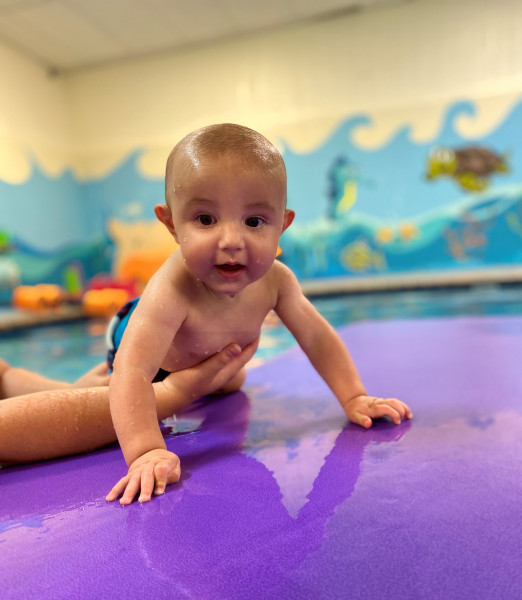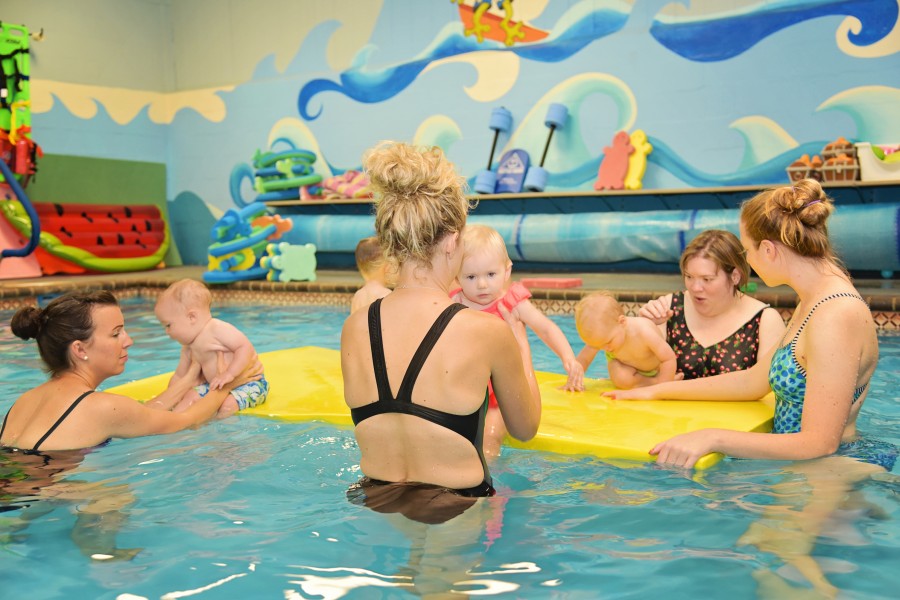 What is Water Babies?
What is Water Babies?
Our Water Babies class is the very first class we offer for newborns as young as 4 weeks. The only requirements is that the child’s umbilical cord has already fallen off and that the child have a little bit of head control. Most newborns have reached both of these milestones by 4 weeks. In the Water Babies class parents will have the opportunity to bond with their child in a very unique and comforting way that is also a more familiar environment for the baby. We do not submerge children until the instructor feels they are developmentally prepared to do so and we feel this class is a great opportunity for relaxed bonding.
There are a few restrictions in our Water Babies program. Students must be 4 weeks old and can remain in the class until they turn 6 months old, at which point they will be promoted into Little Swimmers 1. Depending on the child’s birthday, they could be promoted at the end of the month before they turn 6 months (i.e. a child with an early birthday will be promoted at the end of the month previous). Check with the office for specific withdrawal dates.
Due to the overwhelming popularity of this class, we have a strict attendance policy. Students who miss two consecutive weeks without contacting us in advance OR miss a total of 4 lessons will be automatically withdrawn from the class, so that other students have the opportunity to enjoy the class. Students can only attend one Water Babies lesson per week and we do not offer make-ups for missed or cancelled lessons. All children under the age of 3 years old are required to wear two reusable swim diapers, a Finis and a Happy Nappy over top. These go down to a newborn size and are available to purchase in our office. Feel free to contact us with any other questions or enroll online!
Why do we start so young?
#1 REDUCES THE RISK OF DROWNING
- A case-controlled study conducted by Ruth Brenner and her colleagues discovered that participation in formal swimming lessons can reduce the risk of drowning by 88% among children aged one to four years. The authors concluded that swimming lessons “should be considered for inclusion as part of a complete prevention program.” In a case-controlled study in rural China, Dr. L. Yang and his associates reported a 40% reduction in drowning risk in open bodies of water for children participating in formal swimming lessons.”[2]
- In a case-controlled study in rural China,Dr. L. Yang and associates reported a 40% reduction in drowning risk in open bodies of water for children participating in in formal swimming lessons.[18]
# 2 BOOSTS DEVELOPMENT OF WHOLE CHILD
- Scientific studies at the German Sports College Cologne have shown that early year round swimming lessons for young children accelerated their development physically, intellectually and emotionally.
- As compared with a control group which did not take year-round lessons, the children who swam consistently from infancy were significantly stronger and and more coordinated.
- The children scored higher for intelligence and problem solving, which carried over into excellence in academic achievement.
- Emotionally, they were found to have more self-discipline, greater self-control and an increased desire to succeed.
- They rated higher in self-esteem and were more independent and comfortable in social situations than the control groups.[8]
#3 IMPROVES MOTOR DEVELOPMENT
- Studies conducted at Norwegian University of Science and Technology with Dr. Hermundur Sigmundsson and his colleagues found baby swimmers developed better balance, movement and grasping techniques than non-swimmers. This difference persisted even when the children were five years old; the baby swimmers still outperformed their peers in these skills.[15]
- Zelazo and Weiss reported that baby swimmers made “considerable gains in movement required for for turning 180 degrees and reaching for a wall (underwater) for the 16 to 20 month old children.” The researchers concluded buoyancy most likely boosted the infant’s motor development.[19]

#4 ACCELERATES COGNITIVE DEVELOPMENT
- Starting in 2009, Griffith University embarked on a large, 4 year Early Years Swimming Research Project with 45 swim schools Australia, New Zealand and the United States, the largest study of its kind.
- The preliminary results show that children under the age of 5 involved in swimming lessons are more advanced in their cognitive and physical development than their non-swimming peers.
- The results show minor benefits to social and language development.[11]
- In 20011, researchers in Melbourne reported intellectual and physical benefits form early swim lessons.
- The scientist determined children who were taught to swim by 5 years of age had statistically higher IQ’s.
- The research also showed that moving in high water resistance strengthened the children’s muscles more rapidly than playing on the floor because swimming activates more large muscle groups.[10]
#5 INCREASES MEMORY CAPACITY
- Recent studies have shown the amount of a person’s movement and exercise affects the size and memory capacity of their hippocampus.[12] The hippocampus is an area of the brain primarily associated with memory and learning.
- Draganski and Gaser observed an increased number of neurons in the hippocampus of humans in a controlled exercise program.[6]
- Art Kramer and his colleagues at the University of Illinois and the University of Pittsburgh discovered that ” higher fit people have a bigger hippocampus.” They concluded that more tissue in the hippo-campus equates with increased ability in certain types of memory.[12]
# 6 EXPANDS CEREBRAL COMMUNICATION
- Fascinating new research reports that a baby’s brain develops through bilateral cross patterning movements like swimming, crawling and walking.
- The more cross patterning movements, the more nerve fibers develop in the corpus callosum in the brain. The corpus callosum facilitates communication, feedback and modulation from one side of the brain to the other.
- Cross patterning movements like swimming activate both cerebral hemispheres and all 4 lobes of the brain simultaneously, which can result in heightened cognition and increase ease of learning.
- Good communication in the cerebral hemispheres leads to overall efficiency in brain processes, while poor interaction slows down language development and academic learning.[4]
#7 STRENGTHENS SOCIAL CONFIDENCE
- In a longitudinal study, Dr. Liselott Diem and her colleagues reported that children who had taken part in baby swimming lessons from the age of 2 months to 4 years were better adapted to new situations and had more self confidence and independence than non-swimmers.[5]
- Swim class has abundant opportunities to share space with other children and to explore movement together.[3] The child cooperates within a social structure to learn by observing and mimicking.
- Feeling special, loved and wanted builds self-esteem through a a sense of belonging. “Being part of a group also contributes to the child’s social development.'[14]
#8 ENHANCES NEUROLOGICAL DEVELOPMENT
- The child experiences a great deal of tactile stimulation from the water resistance over the entire body while swimming which encourages neurological development.
- Results of research by Dr. Ruth Rice revealed that infants made “significant gains in neurological development, weight gain and mental development” from the tactile stimulation of the nerve pathways of the skin and vestibular nerve cells.[13]
- Water has over 600 times the resistance of air. Tactile experiences and interactions in the water are important for overall neural organization.
Contact us or click the link below for more information about our infant/toddler program!
REFERENCES
- Ayers J. Sensory Integration and the Child. Los Angeles, CA. : Western Psychological Services;1991: pp.1-67
- Brenner R.A. Gitanjali S.T., Haynie D.L., Trumble A.C., Qian C., Klinger R.M., Klebanoff M.A., Association Between Swimming Lessons and Drowning in Childhood: A case control study. Archives of Pediatrics and Adolescent Medicine 2009; 163(3):203-210
- Connell G., Todd A., Reference Manuel for Early Childhood in Water. Auckland, New Zealand: Swimming New Zealand; 2007.
- Dennison P.E. “Massage the Brain-Button and Learn.” News magazine, Online-www.ehostvgw3.epnet.com/fulltext.aspresultSetld=R00000002&hitnum=5&booleanTer.
- Diem, Undeutsch, Lehr, Olbrich, “Early Motor Stimulation and Personal Development: a study of four to six year old German Children.” Extract by Editor. Swimming World 21 (12):14, 1980
- Draganski B., Gaser C., “Changes in Gray Matter Induced by Training.” Nature 427;2004:pp.311-312.
- Field T., Scafidi F., Scanaberg S., “Message of Preterm Newborns to Improve Growth and Development.” Pediatric Nursing.; 13: 385-387.
- German Sports College Cologne, “Baby Swimming: Advance Independence and Development of Intelligence.” World Aquatic Babies and Children Network, online-www.wabcswim.com: 1979.
- Hannaford C. Smart Moves. Arlington, Virgina, Great Ocean Publishers; 1995.
- Healthmade Magazine, “The Benefits for Swimming Especially for Children-The Function to teach Swimming to Infants.” March 8, 2011.
- Jorgensen R., Grootenboer P., Funnell B., “Early Years Swimming Research Project at Griffith University.” Splash Magazine; July 19,2011. online-http://www.griffith.edu.au/__data/assets/pdf_file/0019/470251/early-year-swim-interim-report-2012.pdf
- Kramer A.F., Erickson K.I., Colcumbe S.J., “Exercise, Cognition and the Aging Brain.” Journal of Applied Physiology; 2009; pp. 101, 1243-1251.
- Rice R., “Neurophysiological Development in Premature Neonate Following Stimulation.” Developmental Psychology, 13; 69-76, 1977.
- Rosengren L.,Baby Swim: The Beginning of a Life Long Adventure. Uppsala, Sweden. Uppsala Publishing house; 2004.
- Sigmundsson H., Hopkins B. “Baby Swimming Exploring the Effects of Early Intervention on Subsequent Motor Abilities.” Child: Care, Health and Development, Science Daily 210, 36 (3): 428 DOL:10.1111/j.1365-2214.2009.00990.x. May 7, 2010.
- Whitehead, L.E. Move and Learn: The Power of Movement.Raleigh, North Carolina. Lulu Press, 2008.
- Whitehead L.E. Movement: The Keys to Early Learning. Raleigh, North Carolina. Lulu Press, 2010.
- Yang L. Nong ll,Li CL,Feng OM, Lo SK “Risk factors for childhood drowning in rural regions of a developing country: a case-control study.” Injury Prevention 2, 13(3): 178-182.
- Zelazo P.R., Weiss M.J., “Infant Swimming Behaviors: Cognitive Control and Influence of Experience.” Journal of Cognitive Development 7 (1); 2006: pp. 1-25
- Whitehead L., “Scientific Benefits of a Baby Swim Lessons.” Mesa, Arizona.
